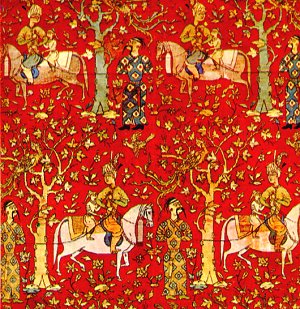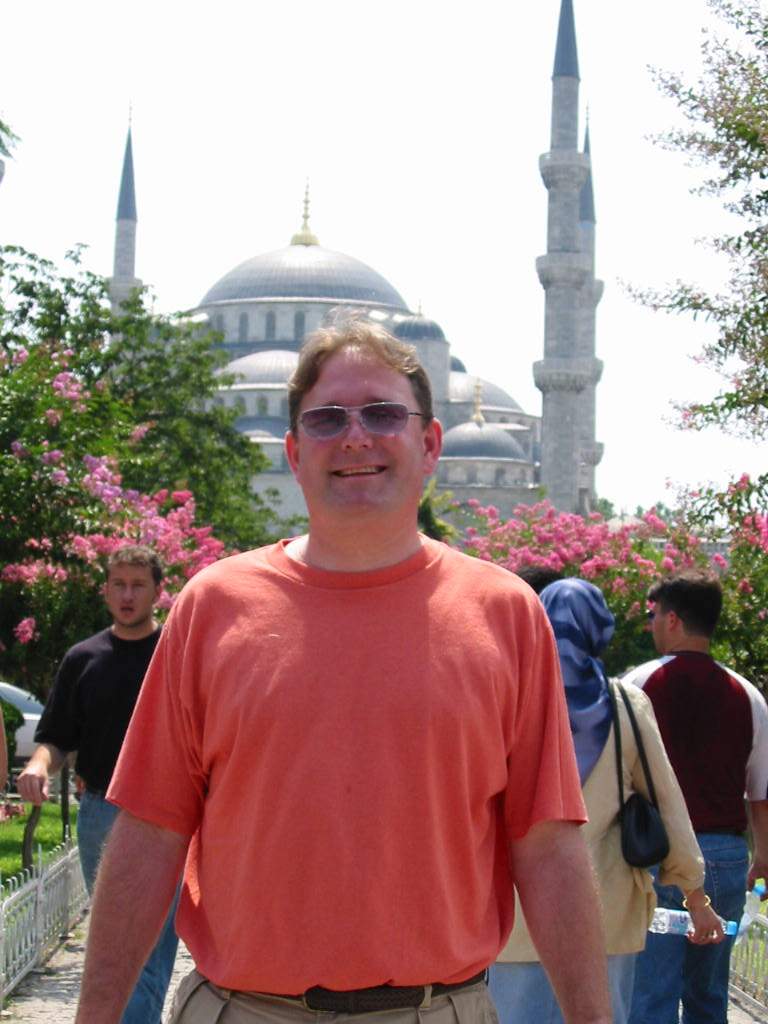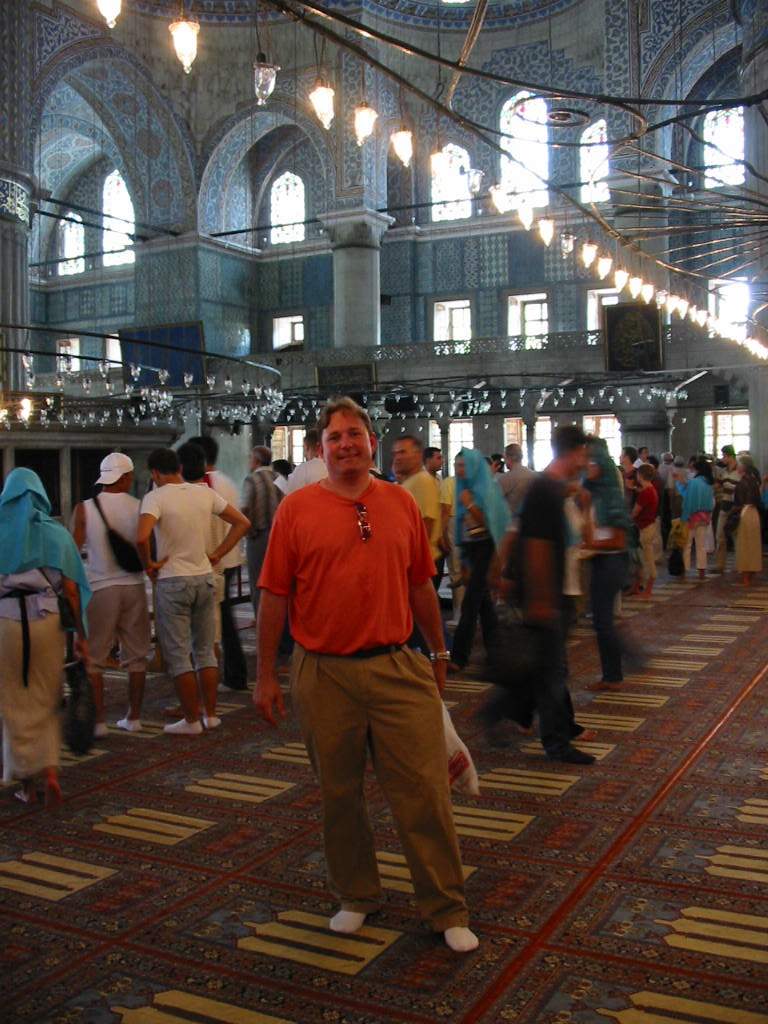 Muslim
Empires WebQuest
Muslim
Empires WebQuest

This
Arabic Symbol Translates to: "The shining sun, which Allah placed
for
everyone"

For
Mr. Stanton's AP World History Class
Introduction | Task
| Process | Resources | Evaluation
| Conclusion


 INTRODUCTION
INTRODUCTION 

For more than six centuries, from about 1290 until 1922, the Ottoman
Empire was one of the world's great powers. The center of the empire
was
located in Anatolia, in the region of modern day Turkey. At the height
of its influence in the 1500's, it was the mightiest empire on earth.
It
nearly surrounded the Mediterranean Sea, covering much of southeastern
Europe, northern Africa, and the Arab Middle East.
The Safavids became a ruling dynasty that dominated Persia, known
as Iran today, in the 1500’s and 1600’s. Named for an ancestor by the
name
of Safi Al-din, who ruled in the late 13th Century, the Safavid family
became the spiritual leaders among a number of Turkish tribes east of
Asia
Minor establishing their empire near the Caspian Sea.
The Mughal’s were a Muslim dynasty in India founded in the
16th Century by a descendant of both Genghis Khan and Timur-i Lang who
was called Babur. The dynasty ruled most of the Northern Indian
subcontinent
until the mid-18th century. The word Mogul is the Arabic and Persian
version
of Mongol.
Introduction
| Task | Process | Resources
| Evaluation | Conclusion

Shah Jahan's Taj Mahal


 THE
TASK
THE
TASK 

Answer the
following
Essential Questions:
-
What were the similarities and differences
between
the three Muslim empires?
-
What weaknesses were common to all of the
Muslim
empires?
-
What were the differences and comparisons in
the
social and economic organization of the Ottomans, the
-
Safavids, and the Mughals?
-
What were the reasons for the decline of the
Mughal
dynasty?
-
What were the causes of the Ottoman decline
in the
17th century?
-
What were the similarities and differences in
the
decline of the Abbasid and Ottoman
empires?
Group
Organization:
Student
Activities:
Each team
must include the following 3 parts:
 ANSWERS TO WEB EXPLORATION QUESTIONS
ANSWERS TO WEB EXPLORATION QUESTIONS BIOGRAPHIES
BIOGRAPHIES MAPS
MAPS

 THE
PROCESS
THE
PROCESS 

 Students
work in teams of 2
Students
work in teams of 2 All
team members work on completing the biographies, gathering of maps,
completing
the questions, and the completing the final document.
All
team members work on completing the biographies, gathering of maps,
completing
the questions, and the completing the final document.
EACH
GROUP SHOULD PRODUCE AND PRINT A DOCUMENT THAT HAS THE FOLLOWING
COMPONENTS
1. Complete
answers to the 10 sets of questions that relate to the associated
web sites below .(3
points each, 30 points total)
2. Three, one paragraph biographies,
on what you consider to be the most influential
(3 points each, 9 points total)
a) Ottoman Sultan
b) Safavid Shah
c) Mughal Emperor
3.
Pictures or Drawing of each of the Sultan, Shah, and Mughal Emperor you
write your biographies on. (1
point total)
4.
Maps on each of the three empires at various stages of their
development
(the maximum is 3 maps and the minimum is 2 for each of the three
empires)
and one map of the 3 empires together. (It is your decision what
maps to use and how you would like to organize them.) (1
point for each empire set and 1 point for the region map with all three
empires, 4 points total)
GO TO ASSOCIATED WEBSITE AND ANSWER THE FOLLOWING QUESTIONS
Answer each question carefully. DO NOT skip any question
in any set or you will loose points. Make sure to fully explain your
answer.
Answers that are too short will loose points.
Go to each website first, read the
article,
and view the images (if included) then answer the question in your own
words.
-
The
Taj Mahal - Why was the Taj Mahal built and for whom was it
built? How have Europeans tried to claim it as their own? How have
Hindu
nationalists tried to claim it as a Hindu design?
-
Akbar the Great
- What early experiences shaped Akbar's attitude towards
religion?
What experiences led him to develop the Din-i-Illahi? How well would
the
values embodied in this semi-official religion have served the Mughal
Empire
had it been widely adopted? Could it have been widely adopted? Who
would
have opposed its wider adoption?
-
Aurangzeb:
A Political History - Using the information provided at this site
and
its links to Aurangzeb’s religious policies, explain how Aurangzeb’s
religious
policies, his intolerance for rival politics on the subcontinent, and
his
expensive military campaigns eroded the foundations of the empire laid
by Akbar without providing a new basis for its administration.
-
The
British East India Company - What brought the company to the verge
of bankruptcy and led to government intervention in its affairs? What
impact
did early British rule have on Bengal? What was “indirect rule” and the
“Doctrine of Lapse (which had no basis in India Law as the British well
knew)? What policies eventually brought about the end of the Company?
-
Fundamentals
of Ottoman Rule - What were the chief elements of Ottoman rule? How
did these serve as both the pillars of Ottoman strength and sources of
weakness?
-
Suleiman
the Magnificent - Why does Suleiman deserve his status as a great
legal
reformer and administrator? What do you believe made Suleiman such a
great
leader? How would Suleiman compare with contemporary Western rulers?
What
happened after the death of Suleiman?
-
Roxelana
& The
Wife of Suleiman - What were the origins and impact of the career
of
Roxelana in the Ottoman Court? How does the account of a European
visitor
summoned into her presence indicate that she was a formidable
intelligence
gatherer for her husband? How were her court intrigues typical of
Mughal
and Ching court politics?
-
The
Janissaries
- Why was the recruitment of troops from non-Muslim peoples considered
a good idea? How did the tradition start? How did the Janissaries
become
more than merely a military institution? How was the reform of the
Ottoman
military typical of Ottoman reforms in general? How did this style of
reform
differ from that in Western Europe?
-
Ottoman
Science: Smallpox Vaccination - What is Lady Montague’s seeming
opinion
of Ottoman society and their attitude towards medical preparations?
What
is her seeming opinion of Western doctors?
-
The
Safavids
- How would the use of legends from pre-Islamic Iran or Persia be of
use
to the Safavids? How did Isma'il gain control of Safavid Persia? Why is
Abbas I considered the greatest of the Safavid leaders? How does
Safavid
Persia go into decline?
Please Note: You need to use Microsoft
Word to put your final Document together. If you do not know how to
attach
pictures to a word document, or if you have difficulty doing so, you
may
print your pictures and maps separately from your biographies and the
answers
to the ten questions.
Introduction
| Task | Process | Resources
| Evaluation | Conclusion


 RESOURCES
RESOURCES 

A.
PRINT RESOURCES
B.
INTERNET LINKS TO USE:
Introduction
| Task | Process | Resources
| Evaluation | Conclusion


 EVALUATION
EVALUATION 

The
final product
is worth a total of 44 Points. Students will be evaluated according to
the following:
-
GROUP GRADE FOR FINAL PRODUCT (Up to 44
points each)(see
The Process section above)
-
INDIVIDUAL GRADE FOR GROUP PARTICIPATION
(Points
will be deducted if participation is unequal)
-
FINAL ASSESSMENT UNIT III TEST
Introduction
| Task | Process | Resources
| Evaluation | Conclusion

Safavid
Silk Rug from the Persian Safavid Period


 THE CONCLUSION
THE CONCLUSION 

I hope that
you have enjoyed your journey back to the Muslim Empires and that you
were
able to answer the exploration questions. You should now have an
understanding
of how the Muslim Empires ruled their various territories and the
effect
these empires had on the world of their time. You should also have an
understanding
of how these empires contributed to the shape of today's world.
Introduction
| Task | Process | Resources
| Evaluation | Conclusion


Mr.
Stanton at the Blue Mosque in Istanbul, Turkey. (Summer of 2002)






SPECIAL NOTE
This site was designed by Mr. Eugene Stanton.
This lesson is based on one found at:
http://occawlonline.pearsoned.com/bookbind/pubbooks/stearns_awl/chapter1/deluxe.html
and is associated with the "World Civilizations" textbook, used in
class.
















